How to load dishes in the dishwasher: the rules of operation of the dishwasher
Using a dishwasher is an opportunity to free up time and save yourself from the work that a technician can do. However, illiterate operation can turn equipment useful in the household into an endless “headache”. Moreover, most violations are associated with improper loading of dishes in the unit tank.
We will tell you how to load dishes in the dishwasher. Let’s show you in what order to place the kitchen utensils for the perfect result of sanitary treatment. The article we presented gives advice on choosing tools for working and caring for equipment.
The content of the article:
Causes of damage to dishes in the car
There are quite a few limitations that limit the possibilities. dishwasher use, and inept handling of equipment and improper loading leads to unexpected results. The conditions that are created in the dishwasher limit the possibility of washing certain types of dishes in it.
Factors that narrow the functionality of the technique:
- very hot water;
- temperature changes;
- hot air drying;
- aggressive chemicals;
- prolonged contact with water, steam.
Temperature shock can crack even glassware made from tempered glass, which normally tolerates hot temperatures.
In some models of dishwashers, this factor is taken into account - the built-in heat exchanger eliminates sudden changes in temperature.
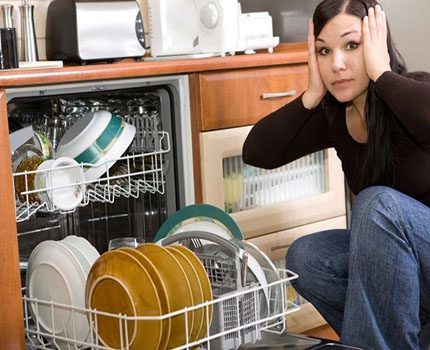
Material Type Restrictions
Cutlery and items made from materials such as: are not loaded into the dishwasher.
- Wood. Stylized antique tableware, spoons, plates, shovels and cutting boards due to contact with hot water can completely deteriorate. The tree will swell, and upon drying it will begin to crack and change its shape.
- Plastic. The restriction applies to items that are made of plastic that does not tolerate high temperatures.
- Copper, tin, silver. From contact with chemicals, they can fade, change color, oxidize.
- Aluminum. Frying pans, pots, meat grinder parts and other aluminum products darken, plaque forms on their surface. Prolonged contact with water is also undesirable.
It is also undesirable to wash cast-iron dishes in the machine, since strong detergents help to remove the protective layer from them and the appearance of rust.
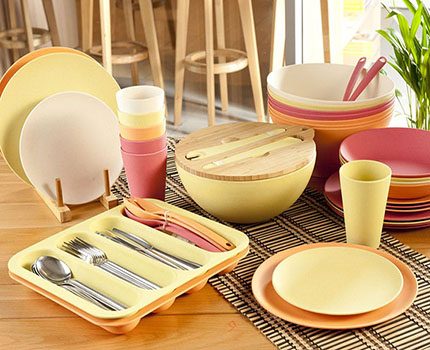
A complete list of items allowed and prohibited for loading into the dishwasher given hereWe recommend that you read some very useful information.
Dishes not compatible with dishwasher
Manufacturers do not recommend loading such dishes into the machine:
- Knives, chopping knives. When heated, they become dull, so it is undesirable to wash them at high temperature.
- Frying pans, stewpan with teflon coating. The protective layer of the pan, under the influence of detergents, is washed off, and it loses its non-stick properties.
- Dishes with a vacuum lid, a seal. Under the influence of hot water, the seal is broken, the seal will deteriorate.
- Items with decorative painting. The paint used to decorate the dishes may be washed off.
- Items stained with ash, grease, paint, wax. Everything that can stain the equipment and lead to its clogging.
In addition to the general rules, there are also restrictions for specific dishes - after all, porcelain and plastic can have different compositions and react differently to the harsh conditions of machine washing. Therefore, when buying and before loading them into the dishwasher, check their markings.
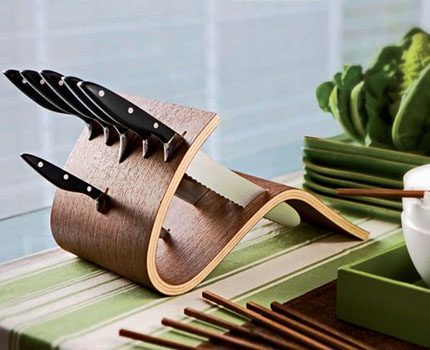
Rusty appliances cannot likewise be immersed in a dishwasher. They will not only undergo further destruction, but will also lead to the formation of rust on metal cutlery not yet touched by corrosion.
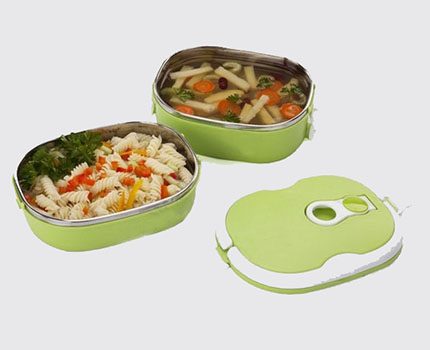
Rules for the use of technology
Broken or unwashed dishes with food debris, clogged drain, corrosion inside the device’s case - all these are consequences of improper operation of the equipment. In order not to have to fix errors, it is better to study the loading rules before using it.
General layout rules
Before loading the dishes into the dishwasher, the remnants of food are removed from it - just remove it with a spoon.
It is not only unnecessary to pre-wash kitchen utensils, but it is also not recommended, since in this case the sensor technology selects a weak mode of the cleaning program and persistent dirt is not washed off.
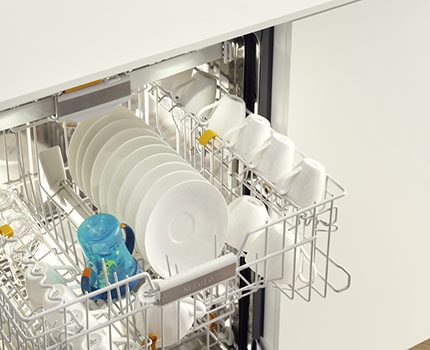
There are rules that clearly prescribe how to load dishes and cutlery into the hopper of the dishwashing equipment:
- All items must be stable.Plates are installed in special lattices, for tall glasses it is also necessary to provide support (for this, a small shelf located above the upper basket and holders are often adapted).
- Dirty utensils are placed in the bottom of the dishwasher. There, the flow of water is stronger and the washing more thorough. In addition, dirty water will not drain onto cleaner appliances.
- All containers are placed upside down so that water does not accumulate in them. Concave and convex objects are placed at an angle, so that water will drain better.
- Tall and narrow containers must not be installed in corners, in an inclined position.
- Nothing should block the rotation of the rocker arms that spray water.
You can also not overload the basket for dishes and place in the box for tablets of detergent any objects.
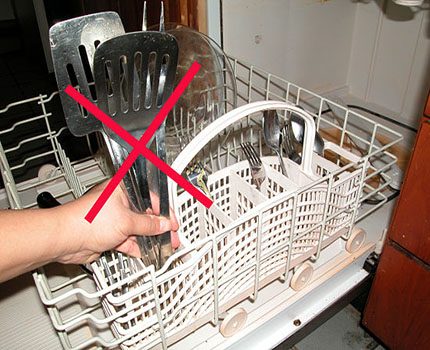
Utensils for placing dishes
In the design of the dishwasher, for the stable and safe location of the dishes, the following devices are provided:
- Folding pins - designed to securely fix bowls, glasses, pans.
- Shelf for knives - suitable for placing all long objects (stacked horizontally).
- Small item holders - securely hold light objects such as lids, plastic cups, etc.
- The upper basket (box) - for loading cups, glasses, small plates. It can be placed at different heights.
- Lower basket (box) - designed for large utensils, pots, pans, as well as for heavily soiled appliances.
In addition to basic accessories, you can additionally purchase a silver washing cassette, a bottle holder, a nozzle for washing trays, an arm for tall glasses, a box for glasses and wine glasses, etc.

Loading rules for each type of cookware
The internal structure of the machine, the location and design of the boxes and shelves in it, are thought out in such a way as to provide the user with convenience and safety for the dishes.
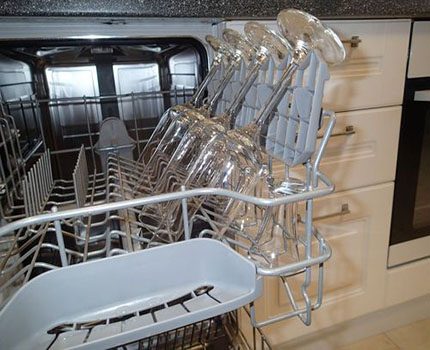
In order for tableware to be placed steadily, washed thoroughly, and not interfere with the effective functioning of the equipment itself, there is a place for each type of tableware:
- Knives, skewers. They are placed on a special shelf in a horizontal position or in a cutlery basket (spoons, forks) with their points pointed down.
- Spoons, shoulder blades. A special basket is designed for them, they are placed vertically.
- Cooking spoons, skimmers. As well as other long cutlery. Stacked on folding shelves, which can be installed at different heights and tilted up if necessary.
- Cups, glasses. Load in the upper basket upside down, in an inclined but stable position.
- Plates, bowls. Put in special sections, if possible through one.
- Pots, pans. They are placed upside down in the lower basket.
Small cutlery is placed on shelves or in fine-mesh baskets. If they are so small that they fall out of the basket, it is better to wash them by hand.

The following video will familiarize you with the intricacies and specifics of the proper arrangement of tableware when loading into the PMM:
Removing dishes after washing
It is necessary to remove the dishes from the machine after it has cooled to a comfortable temperature so as not to burn yourself. In addition, hot glass and porcelain dishes are susceptible to shock and may crack or crack when unloaded. So that drops from dishes placed in the upper box do not drip onto devices located below, they must be unloaded, starting from the bottom.
Dishwashing and water softeners
Failure to comply with the loading standards of preparations for the dishwasher, erroneous setting of systems that dispense funds, any deviations from the established rules lead to disruption of the dishwashing process. As a result, at the end of the program, you can observe the remnants of the funds on the dishes, poor quality of washing.
For washing it is used: detergent, salt, rinse aid. The rules for their use are described in detail by each manufacturer of dishwashers.
Water softening salt
To clean the dishes well and to avoid the appearance of a layer of scale, it is necessary to soften the water. This is especially true when using water with a high degree of hardness. Regenerating salt loaded into the container of the device for softening water. The amount of load is regulated depending on the stiffness indicators.
It is possible to determine exactly how much a softener should be used based on data on the hardness of tap water in a specific region. The amount of salt for different hardness levels is indicated in the standard table.
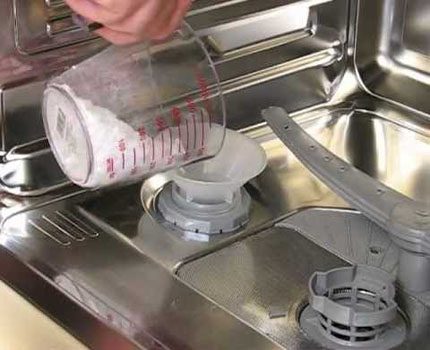
Rinse aid
The product is used to prevent stains from drops of water remaining on the dishes. Loading rinse aid into the container.
When the indicator of the dishwasher turns on, it signals that the rinse aid is left for 1-2 loads. The portion size that is fed into the system can be adjusted by setting it to a stage from 1 to 4.
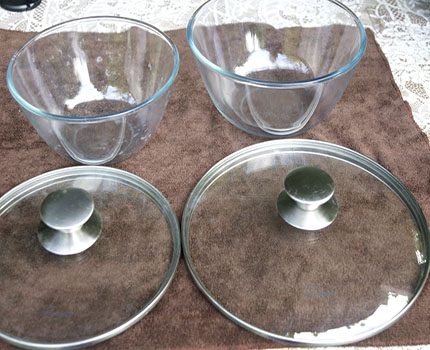
Suitable detergents
As a part of detergents, slightly alkaline substances are used with the content of enzymes that dissolve proteins and break down starch. Some of them contain oxygen bleaches and cope well with stains from tea, ketchup.
It can be produced in the form of a liquid, powder0 tablets. The first two options allow automatic dispensing by the dishwasher of the required amount of product. In the question, which is better: powder or tablets, help us figure our recommended article.
The tablet is fully used, but sometimes in order to save it, they are divided in half. The rules for using funds from different manufacturers may differ, therefore, before using, they study the information on the package.
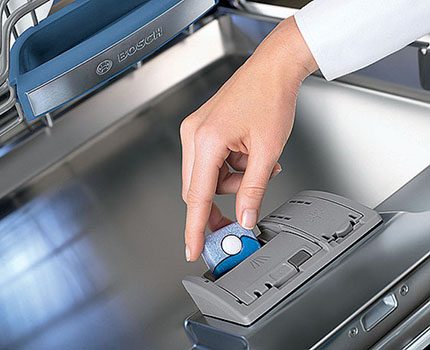
Use combined products, which include detergents, softening salt, rinse aid, if the hardness of your tap water is not higher than 21 ° dH. When using 3 in 1 products, the rinse aid and salt indicators turn off - most machines support this function.
There are also 4 in 1 and 5 in 1 products, which include additional components to shine stainless steel or to protect glass.
Rules for the safe use of the device
Operation of the dishwasher involves the implementation of safety measures in the same way as any other equipment:
- Only detergents are used. specialized compoundsdesigned for dishwashers.This is especially true for those that contain chlorine.
- During operation of the device, the door must be closed. It is necessary to check whether the placed inside the dishes prevents this. Leakage is indicated by an infrared indicator.
- Care must be taken to open the door during the program so as not to be scalded with water that could splash out of the machine.
- The door of the machine can be in the open state only during unloading or loading the dishwasher, otherwise you can trip over it while moving around the kitchen.
- The door should not be heavily loaded, do not sit down and do not stand on it.
- When installing a dishwasher, including a built-in one, you must clearly follow the installation rules developed by the manufacturer.
It is especially necessary to be careful when operating equipment if there are children in the house, and to purchase those models of devices that have child protection programs and block the doors of the machine, preventing unauthorized access.
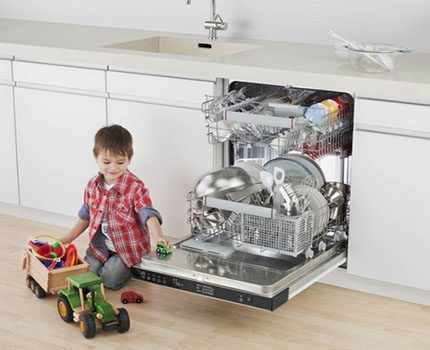
Maintenance and cleanliness
Like any equipment, a dishwasher requires a competent attitude. After a certain period of operation of the device, accumulation of fat and scale can be observed, and a humid environment leads to the appearance of fungi.
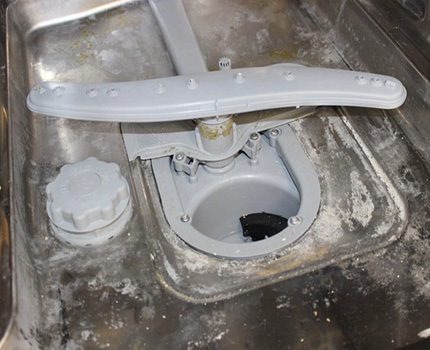
They clean the filters of contaminants that are standard for dishes and rinse them under running water after each wash. Spray arms are less often cleaned of scale and dirt. Each manufacturer of the dishwasher in its instructions contains information on how to properly remove and clean removable items.
Regular execution dishwasher cleaning and compliance with operational rules will significantly extend the operational life of the equipment and save you from repairs and replacement of expensive components.
Special attention should be paid to the seal on the machine door - wipe with a damp cloth slightly moistened with detergent. The front panel with controls is also kept clean without the use of a sponge with an abrasive surface.
Periodically, it is required to automatically wash equipment using sanitizer hopper and inaccessible sections of the unit. If the device is not used for a long time, in order to avoid the formation of fungus and the formation of an unpleasant odor, its door is kept ajar.
All manufacturers of dishwashers apply detailed Operating Instructions. For the normal operation of the equipment, it is necessary and necessary to adhere to the rules indicated in the manual.
Conclusions and useful video on the topic
Scientific approach to loading a dishwasher:
Surely, you have not washed these items in the dishwasher and you will be interested to watch the video:
Most of the problems and malfunctions that arise during operation of the dishwasher are a consequence of its improper use. A competent attitude to technology and care will help not only to preserve the appearance of kitchen accessories, but also to extend the life of the device itself.
Want to talk about how you load dishes into your “home helper”? Have a desire to share the secrets of rational use of space in the bunker? Please write comments in the block below, post a photo on the topic of the article, ask questions.

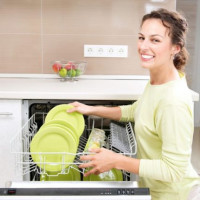 How to choose a dishwasher: selection criteria + expert advice
How to choose a dishwasher: selection criteria + expert advice 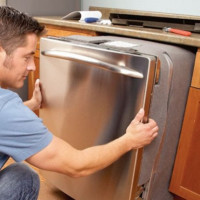 Installing the facade on the dishwasher: tips + installation instructions
Installing the facade on the dishwasher: tips + installation instructions 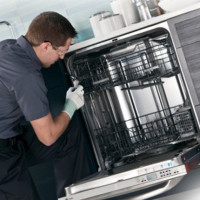 How to integrate a dishwasher into a finished kitchen: installation options + work procedure
How to integrate a dishwasher into a finished kitchen: installation options + work procedure 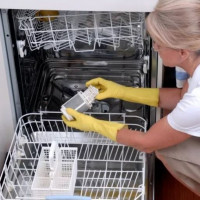 How to clean a dishwasher at home: the best mechanical and chemical methods
How to clean a dishwasher at home: the best mechanical and chemical methods 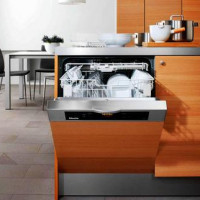 How to choose a built-in dishwasher: what to look for when buying + an overview of the best brands
How to choose a built-in dishwasher: what to look for when buying + an overview of the best brands 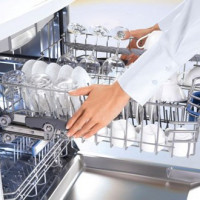 How to use a dishwasher: rules for use and care of the dishwasher
How to use a dishwasher: rules for use and care of the dishwasher  How much does it cost to connect gas to a private house: the price of organizing gas supply
How much does it cost to connect gas to a private house: the price of organizing gas supply  The best washing machines with dryer: model rating and customer tips
The best washing machines with dryer: model rating and customer tips  What is the color temperature of light and the nuances of choosing the temperature of the lamps to suit your needs
What is the color temperature of light and the nuances of choosing the temperature of the lamps to suit your needs  Replacement of a geyser in an apartment: replacement paperwork + basic norms and requirements
Replacement of a geyser in an apartment: replacement paperwork + basic norms and requirements
I have never had a dishwasher, and now I choose the first one. I’ve already re-read so many things, but still in my head there is no complete clarity of how she works and how the mistress “behaves” with her. A baking tray for an oven - it is large, are there such dishwasher models where it will go? Or will you have to wash it with your hands? Fragile, almost transparent coffee cups (I have a pair of Czech porcelain) - can I bet if their machine will not hurt if I suddenly set it so that it moves during the washing process?
Hello Marina! I have the dimensions of the pan 60 * 60 cm, and the dimensions of the dishwasher 50 * 70 cm, i.e. the pan is 10 cm wider than the PMM. I put the baking sheet at an angle (photo below). It is perfectly washed, and next to it a couple of cups / plates are placed.
As for fragile dishes, they need to be placed tightly together and make sure that other dishes cannot damage porcelain. For example, I had a case when a crystal glass was damaged by a knife, which was not placed in a grid for cutlery, but simply laid next to it. If you follow the instructions and arrange the dishes as recommended by the manufacturer of the PMM, then the risk of breaking or scratching it is minimized.
Most of the rules and recommendations for using a dishwasher are in the instructions for it. It is a pity that with us people often open it only when something has already gone wrong. I immediately paid her due attention, and for two years of use, no problems have ever arisen. The only thing - it was not immediately possible to set it up correctly, at first there was a detergent on the dishes.